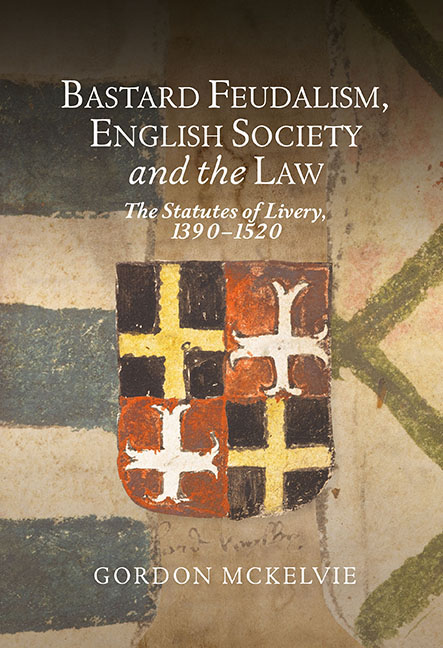Book contents
- Frontmatter
- Contents
- Acknowledgements
- Abbreviations
- Timeline of Parliamentary Activity
- Introduction
- Chapter 1 The System – Liveries and Retaining
- Chapter 2 The Early Years, 1390 to 1449
- Chapter 3 The Later Years, 1449 to 1520
- Chapter 4 Outcomes and Enforcement
- Chapter 5 The Identity of the Indicted
- Chapter 6 The Geography of the Cases
- Chapter 7 Networks and Localities
- Chapter 8 Livery and Disorder
- Chapter 9 The Urban Experience
- Conclusion
- Appendix 1 Number of Cases by Reign
- Appendix 2 Number of Cases in each County
- Appendix 3 List of Letters to Towns and Lordships
- Appendix 4 List of Local Ordinances
- Appendix 5 Letters from Henry VII to Duchy of Lancaster Officials
- Bibliography
- Index
Chapter 6 - The Geography of the Cases
Published online by Cambridge University Press: 02 April 2020
- Frontmatter
- Contents
- Acknowledgements
- Abbreviations
- Timeline of Parliamentary Activity
- Introduction
- Chapter 1 The System – Liveries and Retaining
- Chapter 2 The Early Years, 1390 to 1449
- Chapter 3 The Later Years, 1449 to 1520
- Chapter 4 Outcomes and Enforcement
- Chapter 5 The Identity of the Indicted
- Chapter 6 The Geography of the Cases
- Chapter 7 Networks and Localities
- Chapter 8 Livery and Disorder
- Chapter 9 The Urban Experience
- Conclusion
- Appendix 1 Number of Cases by Reign
- Appendix 2 Number of Cases in each County
- Appendix 3 List of Letters to Towns and Lordships
- Appendix 4 List of Local Ordinances
- Appendix 5 Letters from Henry VII to Duchy of Lancaster Officials
- Bibliography
- Index
Summary
To fully understand the enforcement of the statutes it is necessary to examine where cases occurred as well as when they occurred and who was indicted. The use of counties for understanding social history can be problematic because many were artificial constructs, created for administrative ease. Christine Carpenter has shown that these artificial constructs did not necessarily determine social, political and economic connections as many people regularly formed such connections that crossed county boundaries. The concept of the ‘county community’ is more appropriate to the early modern period than the late medieval period but the county is nevertheless the appropriate unit at which to discuss levels of law enforcement. England was divided into separate counties and justice was administered at this level with JPs having jurisdiction in one county. Gerald Harriss noted that judicial business was one of the few areas in which the whole shire routinely functioned as a political institution. The arrangement of records by county is beneficial for an examination of the efficiency of local law enforcement because it allows a comparison of the ways in which separate county administrations enforced the statutes.
The numerous local studies of late medieval English society and landholding have shown that no two counties had an identical socio-political character as each county had its own idiosyncrasies. Differing patterns of landholding are evident in the Nomina Villarum returns from 1316. In Somerset 77 per cent of vills were held by the gentry while 20 per cent belonged to the church, 2 per cent to the crown and 1 per cent to the greater magnates. In contrast, in Kent the crown held 14 per cent of the vills, while the church held 46 per cent, the magnates held 7 per cent and the gentry held 33 per cent. Sussex similarly had a different composition with the magnates holding 25 per cent of the vills, the gentry holding 45 per cent, the church holding 26 per cent and the crown holding 4 per cent. For Devon, the extensive landholding of Edward Courtenay, earl of Devon, made him the most significant political figure in the county.
- Type
- Chapter
- Information
- Bastard Feudalism, English Society and the LawThe Statutes of Livery, 1390–1520, pp. 131 - 149Publisher: Boydell & BrewerPrint publication year: 2020



